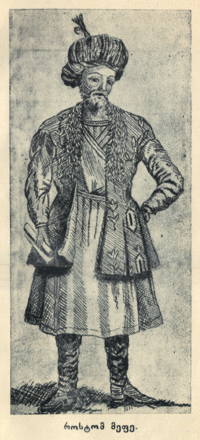Safi of Persia
| Shah Safi | |
|---|---|
|
Mirza (royal title) Shahanshah of Iran, Sahib-i-Qiran, Sultan bar Salatin [1] | |
 | |
| Reign | 28 January 1629 – 12 May 1642 |
| Coronation | 28 January 1629 |
| Predecessor | Abbas I |
| Successor | Abbas II |
| Born | 1611 |
| Died | 12 May 1642 (aged 30/31) |
| Burial | Qom, Iran |
| House | Safavi |
| Father | Prince Soltan Mohammad Baqer Mirza |
| Mother | Dilaram Khanum |
Sam Mirza (1611 – 12 May 1642), (Persian: سام میرزا), better known by his dynastic name of Shah Safi (Persian: شاه صفی) was Shah of Iran from 1629 to 1642. He was the sixth ruler of the Safavid dynasty.
Early life
Safi was given the name Sam Mirza when he was born. He was the son of Mohammed Baqir Mirza, the eldest son of Shah Abbas I, and Dilaram Khanum, a Georgian wife.[2] In 1615, Abbas had Mohammed Baqir killed, fearing he was plotting against his life. Over the next few years, the suspicious Abbas killed or blinded his other sons, leaving his grandson Safi heir to the throne.
Reign
Safi was crowned on 28 January 1629 at the age of eighteen.[3] He ruthlessly eliminated anyone he regarded as a threat to his power, executing almost all the Safavid royal princes as well as leading courtiers and generals. He paid little attention to the business of government and had no cultural or intellectual interests (he had never learned to read or write properly), preferring to spend his time drinking wine or indulging in his addiction to opium. Supposedly, however, he abhorred tobacco smoke as much as his grandfather did, going as far as to have those caught smoking tobacco in public killed by pouring molten lead in their mouths.
The dominant political figure of Safi's reign was Saru Taqi, appointed grand vizier in 1634. Saru Taqi was incorruptible and highly efficient at raising revenues for the state, but he could also be autocratic and arrogant.
Iran's foreign enemies took the opportunity to exploit Safi's perceived weakness. Despite firm initial Safavid successes and humiliating defeats in the Ottoman-Safavid War (1623-39) by Safi's grandfather and predecessor Shah Abbas the Great, the Ottomans, the sworn arch rivals of the Safavids, made incursions in the west in one year following Safi's ascension to the throne. In 1634 they briefly occupied Yerevan and Tabriz and in 1638 they finally succeeded in capturing and gaining a strong foothold in Baghdad and other parts of Mesopotamia (Iraq) which, despite being taken again several times later on in history by the Persians and most notably by Nader Shah, it would all remain in their hands until the aftermath of World War I. Nevertheless, the Treaty of Zuhab which ensued in 1639 put an end to all further wars between the Safavids and the Ottomans. Apart from the Ottoman wars, Iran was troubled by the Uzbeks and Turkmens in the east and briefly lost Kandahar in their easternmost territories to the Mughals in 1638, due to what seems as an act of revenge by their own governor over the region, Ali Mardan Khan, after being dismissed from office.[4]
In 1636 he received a trade delegation from Frederick III, Duke of Holstein-Gottorp, which included Adam Olearius. Adam wrote a book about this visit in 1647, which was widely published in Europe. In 1639, Safi sent a return delegation to Holstein-Gottorp, bestowing gifts on the Duke.[5]
Safi died on 12 May 1642 as a result of excessive drinking,[6] and was buried in Qom. He was succeeded by his son Abbas II.
Issue
Safi I married numerous times;
- m. ca. 1634, a daughter of Manuchar I Dadiani, mtavari of Principality of Mingrelia, by his wife, Princess Tamar.
- m. 1637, Princess Tinatin, younger daughter of Teimuraz I [Tahmuras Khan], King of Kartli and Kakheti, by his second wife, Queen Khoreshan-Darejan, daughter of Giorgi X, King of Kartli.
- m. a daughter of Bika, a Circassian. She was also the sister of Prince Mussal.[7]
- m. a daughter of Urgurlu Beg, his former slave.
- Ana Khanum (d. 9th September 1647), a Circassian lady.
- m. a daughter of a Turkish or Persian court official from Nakhchivan.
References
- ↑ The Royal Ark
- ↑ Sussan Babaie and others: Slaves of the Shah (I.B. Tauris, 2003) p.104
- ↑ Buyers, Christopher. "PERSIA - The Safavid Dynasty (Genealogy)". Retrieved 1 December 2015.
- ↑ Kohn 2007, p. 338
- ↑ Granlund 2004, p. 58.
- ↑ Buyers, Christopher. "PERSIA - The Safavid Dynasty (Genealogy)". Retrieved 1 December 2015.
- ↑ Sale; et al. (1759). "An Universal history, from the earliest account of time". 26. Printed for T. Osborne: 475. Retrieved 18 January 2016.
Sources
- Newman, Andrew J. (2008). Safavid Iran: Rebirth of a Persian Empire. I.B.Tauris. pp. 1–281. ISBN 9780857716613.
- Babaie, Sussan (2004). Slaves of the Shah: New Elites of Safavid Iran. I.B.Tauris. pp. 1–218. ISBN 9781860647215.
- Roemer, H.R. (1986). "The Safavid period". The Cambridge History of Iran, Volume 5: The Timurid and Safavid periods. Cambridge: Cambridge University Press. pp. 189–351. ISBN 9780521200943.
- Granlund, Lis (2004). "Queen Hedwig Eleonora of Sweden: Dowager, Builder, and Collector". In Campbell Orr, Clarissa. Queenship in Europe 1660-1815: The Role of the Consort. Cambridge University Press. pp. 56–76. ISBN 0-521-81422-7.
| Safi of Persia | ||
| Preceded by Abbas I |
Shah of Persia 1629–1642 |
Succeeded by Abbas II |
